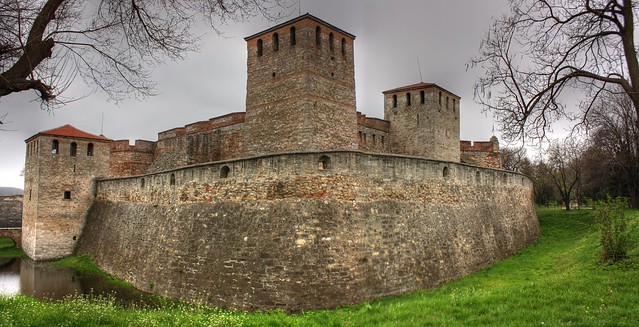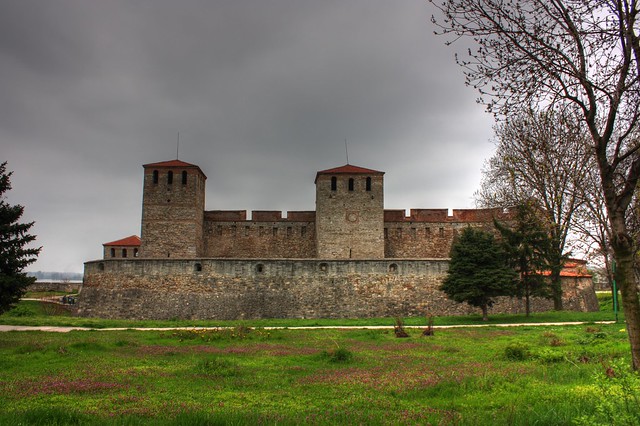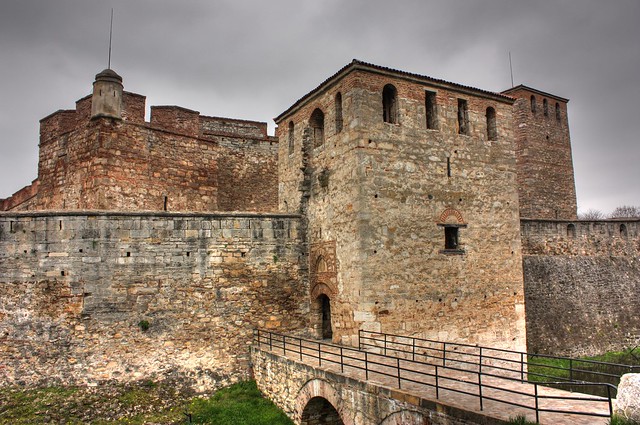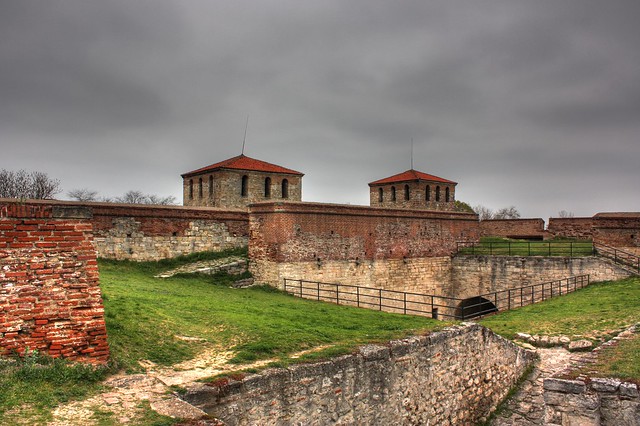

Μια φορά και έναν καιρό ήταν ένας Βούλγαρος αριστοκράτης, ο οποίος είχε στην κατοχή του τεράστιες εκτάσεις από τα Καρπάθια έως τον Αίμο... Μετά τον θάνατο του, οι τρεις κόρες του, Вида (Βίντα), Гъмза (Γκάμζα) και Кула (Κούλα) χώρισαν μεταξύ τους την περιουσία του πατέρα τους... Οι δύο νεότερες κοπέλες, η Κούλα, η οποία εγκαταστάθηκε εκεί που σήμερα βρίσκεται η Βουλγαρική πόλη Кула (Κούλα), και η Γκάμζα, η οποία εγκαταστάθηκε στο Гамзиград (Γκάμζιγκραντ), το οποίο σήμερα βρίσκεται στην Σερβία, παντρεύτηκαν εσπευσμένα... Επέλεξαν, όμως, κακούς συζύγους, οι οποίοι σύντομα ξόδεψαν την κληρονομιά των συζύγων τους... Η μεγαλύτερη κόρη, όμως, η Βίντα, έμεινε ανύπαντρη όλη της την ζωή... Κάτω από τις οδηγίες της κτίστηκε ισχυρό οχυρό, το οποίο πήρε, μετά τον θάνατο της, το όνομα της, "Баба Вида" (Μπάμπα Βίντα - Η γιαγιά Βίντα).

Η ιστορία αυτή πρέπει να έχει ρίζες στην πρώτη εμφάνιση των Σλάβων στην περιοχή, καθώς το σημερινό όνομα Видин (Βίντιν) της πόλης προέρχεται από το όνομα Бдин (Μπντίν) που πήρε η πόλη μετά την εγκατάσταση των Σλάβων εκεί. Πάντως, και στις τρεις πόλεις που αναφέρονται, Видин (Βίντιν), Кула (Κούλα) και Гамзиград (Γκάμζιγκραντ), υπάρχουν κατάλοιπα Ρωμαϊκών οχυρών ή πόλεων.

Η κατασκευή του κάστρου ξεκίνησε τον 10ο αιώνα, στην θέση όπου βρισκόταν ένα Ρωμαϊκό παρατηρητήριο. Κατά την διάρκεια του Μεσαίωνα το Βίντιν ήταν πολύ σημαντική Βουλγαρική πόλη. Το 1003 καταλήφθηκε από τον Βασίλειο Β' τον Βουλγαροκτόνο, μετά από πολιορκία οκτώ μηνών και, όπως λέει η παράδοση, εξαιτίας της προδοσίας του τοπικού Επισκόπου. Το κάστρο τότε καταστράφηκε και ξανα-ανοικοδομήθηκε από τον Βούλγαρο τσάρο Иван Срацимир (Ιβάν Σρατσιμίρ), για τον οποίο υπήρξε η πρωτεύουσα του πριγκηπάτου του. Από το 1365 έως και το 1369 πέφτει στα χέρια των Ούγγρων, ενώ ο Ιβάν Σρατσιμίρ αιχμαλωτίζεται. Το 1369, ο πατέρας του Ιβάν Σρατσιμίρ, Ιβάν Αλεξάντερ, πληρώνοντας υψηλό οικονομικό τίμημα, καταφέρνει να επαναφέρει τον Ιβάν Σρατσιμίρ στον θρόνο, αλλά ως υποτελή των Ούγγρων. Το 1388 οι Οθωμανοί κυριεύουν τις περιοχές του Σρατσιμίρ και τον αναγκάζουν να γίνει υποτελής τους. Το 1396 ο Σρατσιμίρ συμμετέχει σε σταυροφορία του βασιλιά της Ουγγαρίας Zsigmond εναντίων των Οθωμανών η οποία, όμως, καταλήγει στην καταστροφική Μάχη της Νικόπολης, με τους Οθωμανούς, στην συνέχεια, να κυριεύουν σχεδόν όλες τις περιοχές του Σρατσιμίρ.












Κατά την διάρκεια της Οθωμανικής κυριαρχίας, το οχυρό έπαιζε το ρόλο αποθήκης πυρομαχικών και φυλακής... Το 1462 το οχυρό καταλήφθηκε από τον Vlad Ţepeş ή Vlad Drăculea (Βλάντ Τέπες, ο οποίος ήταν η πηγή έμπνευσης για τον θρύλο του Κόμη Δράκουλα). Οι φρικαλεότητες που έγιναν κατά την διάρκεια της εκστρατείας του Δράκουλα στην περιοχή έγιναν γνωστές από ένα ποίημα του Γερμανού ποιητή του Μεσαίωνα Michael Beheim. Συνολικά λέγεται ότι 25.000 άτομα παλουκώθηκαν κατά την διάρκεια της εκστρατείας, ενώ δεν είναι γνωστό πόσοι κάηκαν στους πυρπολισμούς των πόλεων και των χωριών. Σήμερα το κάστρο είναι μουσείο...
Σύνδεσμος σε χάρτη / Link to Map: 43° 59' 34''N, 22° 53' 12''E
[ENG] Vida, Gamza and Kula: Once upon a time there was a Bulgarian boyar (aristocrat), who owned large domains from the Carpathians to the Balkan mountains. After his death his three daughters, Vida, Kulla and Gamza, divided the domains among themselves. The two younger sistrers, Koula (her centre being the Bulgarian town of the same name) and Gamza (her capital was Gamzigrad, presently in Serbia), married hastily. They choose bad men, who carelessly wasted their father's heritage. The eldest sister, Vida stayed single all her life. Under her leadership a castle was built up. She lived in it up to a ripe old age, successfully defending her subjects from hostile assaults. As a sign of gratitude, people named the castle after her name when she died - "Baba Vida" or "The Towers of Baba Vida" [Source]. This story must have its roots in the first appearance of the Slavs in the region, as the current name of the city, Vidin, comes from the name Бдин (Bntin) which was given to the city after the settlement of the Slavs there. However, in all three cities mentioned in the legend, Vidin, Кула and Gamzigrad, there are remnants of Roman forts and cities. The construction of the fortress began in the 10th century at the place of an ancient Roman watchtower. In the Middle Ages, Vidin used to be an important Bulgarian city, a bishop seat and capital of a large province. Between 971 and 976 the town was the centre of Samuil's possessions while his brothers ruled to the south. In 1003 Vidin was seized by the Byzantine emperor Basil II after an eight month siege because of the betrayal of the local bishop. The castle was destroyed and then was restored by the Bulgarian tsar Ivan Sratsimir and was the capital of his principality. From 1365 to 1369 Baba Vida was conquered by the forces of Louis I of Hungary and Ivan Sratsimir was captured. In 1369, Ivan Sratsimir's father, Ivan Alexander, paid a high economic price and manages to restore Ivan Sratsimir on his throne, but as a vassal of the Hungarians. In 1388 the Ottomans conquered the regions of Ivan Sratsimir and forced him to become their vassal. In 1396, he joined an anti-Ottoman crusade led by the King of Hungary, Sigismund, placing his resources at the crusaders' disposal. The crusade ended in the disastrous Battle of Nicopolis at Nikopol, Bulgaria, with the Ottomans capturing most of Sratsimir's domains shortly thereafter, in 1397. The fortress played a significant role during the Ottoman rule of Bulgaria, serving as a weapon warehouse and a prison. In 1462 the fort was seized by Vlad Ţepeş or Vlad Drăculea (Vlad Tepes, who was later the inspiration for the legend of Count Dracula). The atrocities that took place during the campaign of Vlad Tepes became known from a poem of the German poet of the Middle Ages, Michael Beheim. It is said that 25,000 people were were killed and impaled in that campaign, while it is not known how many people were killed from the burning of towns and villages. The fortress was no longer used for defensive purposes since the end of the 18th century. Today, Baba Vida is a fortress-museum [Source].
[BUL] Баба Вида, Видин.








No comments:
Post a Comment